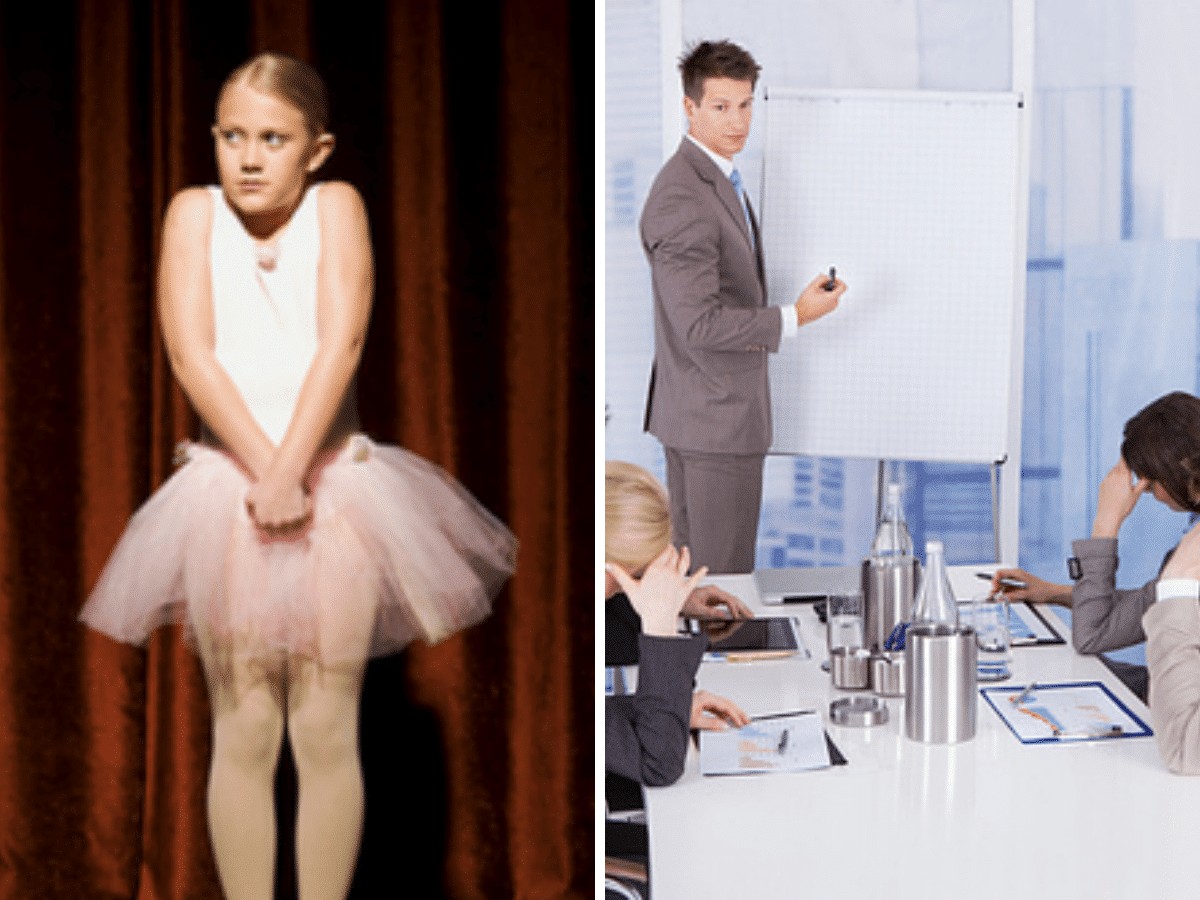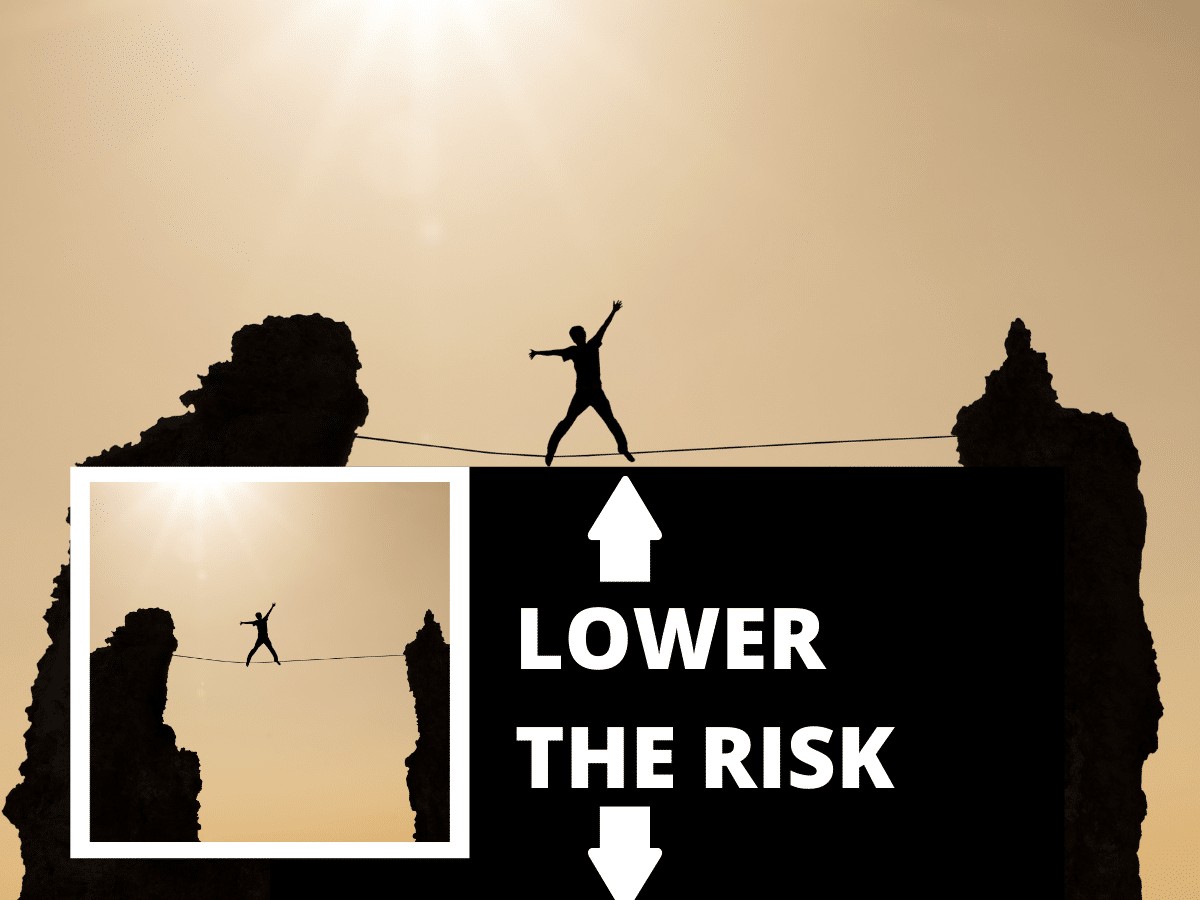
After training over 20,000 class members, our instructors have discovered a few simple truths about stage fright and speech anxiety. Once you understand these secrets, you too really reduce this fear.
Below are a few facts about public speaking fear that can help.
What Is Public Speaking Fear?
Stage fright is still one of the most prevalent anxieties in the world. In fact, psychologists created a specific term for this particular social phobia. They call it glossophobia — which is a form of social anxiety disorder.
Basically, this performance anxiety occurs when a person has to stand in front of a group and deliver a presentation. Since the symptoms of this fear are so common, presenters often have questions about why it’s there, where it came from, and how do you get rid of it?
Most people feel like they are the only ones out there who experience butterflies in the stomach, a shaky voice, or shaky hands. However, just about every speaker has some sort of nervousness when presenting in front of groups. The person may have had a bad experience at a previous speaking engagement. Now, when he or she stands to speak n front of any number of people, the person may feel a lot of nervous energy. If the speech is in front of a large audience, he or she may experience a full-blown panic attack.
As a result, a lot of people who feel that stage fright will avoid public speaking situations altogether. These people can miss out on big opportunities. If public speakers don’t do something about the anxiety, it can escalate and turn into a debilitating phobia. With all that being said, though, here is some really good news. As far as anxiety disorders go, this one is really easy to conquer.
Where Does Public Speaking Fear Come From?
Anytime you try something for the first time, you will feel nervousness or anxiety about that thing.
Remember back when you got on a bicycle for the first time?
Or the first time you tried to drive on the freeway?
The reason why we tend to remember situations like riding a bike or driving a car for the first time is that, in those situations, we felt an imminent threat to our safety. But to a lesser extent, we feel this nervousness constantly when we try something new.
For instance, when I got my first Smart Phone, and I went to the App Store, I was really nervous about downloading that very first “Free App.” I was scared to death that I’d end up with a recurring charge on my phone bill that I’d never be able to get rid of. Years before this, I felt the same way the first time I entered a credit card number into a website form.
So, nervousness is normal when we try something new.
By the way, the amount of nervousness that you feel will depend a lot on how safe you feel. The more imminent the threat to your safety, the more nerve-racking the activity will be. Your fight or flight response will kick in.
For instance, my heartbeat increased more dramatically the first time I went bungee jumping than it did the first time that I bought a book on Amazon. I had to take a few deep breaths before managing to push through the fear and jump off a platform high in the air. However, that was not the case with the online purchase. Sure bad things could happen if my credit card got stolen. But, there was no fear of death.
Public Speaking Fear is NORMAL (and Part of the Growth Process.)

Often, this fear is created in school as we grow up.
I’ve had hundreds of people attend my public speaking classes and tell me that they’ve ALWAYS had this nervousness. I’ve heard stories of that time in 1st grade when they had the singing recital solo and their voice cracked. Or when they were standing in front of the class doing the math problem and choked.
The most common story, though, is the time they had to give the book report to a group of non-judgemental high school students. (Sarcasm.)
Because of these early situations, when we stand up in front of an audience and speak, even if we do okay, we may still consider it to be a failure. The more this happens, the more nervous we will be in future speeches as well.
Many times we might be performing well in our business speech, but if we just THINK that we did poorly, the anxiety will still show up.
If Your Stage Fright Doesn’t Reduce Over Time… Change What You are Doing!
As I mentioned before, nervousness is normal when you begin to speak. However, if it remains over time (or gets worse,) you’re not growing. Try changing what you are doing.
For instance, if you’ve been driving for years, and you still break into a cold sweat when you drive on the freeway, something has interrupted you confidence building process.
“Wait, that’s absurd! No one can drive for 15 years and not gain confidence. Over time, driving becomes second nature.”
Well, only if that new driver continues to practice and grow. If he/she avoids driving and only drives once, maybe twice a year, that fear may remain. In fact, that fear can even grow more intense over time.
The same thing happens with speakers. Instead of practicing, we often avoid opportunities. In other cases, we use crutches to make us feel more comfortable.
Some Things We Do to Reduce Nervousness Actually Make Us Nervous.
The way that most people prepare for a speech actually adds to nervousness versus reducing it.
Here are a few of the common things that people do to try to reduce stage fright but that actually CAUSES FEAR.
-
Starting with the PowerPoint slideshow.
PowerPoint slides are visual aids for the audience — not cheat notes to remember what you’re going to say next. When a presenter starts by creating the PowerPoint deck, he/she will likely create a speak-click-speak-click-speak-click presentation that will be pretty boring. Basically, the presenter is using the slides as cue cards. By the way, once the speech starts to go poorly, the nervousness will increase even more. In Fearless Presentations®, we help participants prepare what they want to say first and then help them design visual aids that made delivering the presentation much easier.
-
Trying to Memorize a Speech.
When a presenter tries to memorize a speech word-for-word and rehearse timings, a number of things can occur that actually cause the nervousness to increase. Things like forgetting part of the speech, speaking to fast and running short of material or speaking to slow and running out of time, and not to mention the time and effort it takes to memorize a speech. Frustration will often set in, and the confidence of the presenter can be harmed. In Fearless Presentations®, we show presenters a very simple step-by-step process to design a speech where the presenter can adjust the timing at will if the requested length of the speech changes at the last minute.
-
Over Rehearsing.
We suggest that a presenter rehearse a “well designed” speech once, maybe twice, and then deliver the presentation. Over-Rehearsing can cause a present to slip into the Memorizing the Speech pitfall.
-
Relying on Notes.
Presenters often feel more comfortable initially if they have the crutch of prepared notes in front of them. However, public speaking is a communication between the speaker and the audience. So when the speaker’s attention is constantly being diverted to the notes in front of him/her, that connection, the rapport, is broken. The person standing in front of a crowd will lose eye contact when he or she refers to notes. The audience reaction will be more sedate as well. This just makes the speaker more nervous. The nervousness will begin to show in the speaker’s body language as well. This whole process is a negative reinforcing cycle that just causes more public speaking anxiety.
-
Listening to Well-Intentioned Co-Workers or Friends.
When we feel uncomfortable, we might turn to a friend or coworker for coaching. The challenge with this is that most people are very quick to pick up on mistakes, but not so quick to pick up on successes.
Remember how above we talked about how success leads to confidence and failures lead to nervousness?
Well, our friends and coworkers will often tell us all of our mistakes so that we can correct them. So we end our coaching session with a series of perceived failures.
So the next time we stand up to speak, if we catch ourselves doing some of these things, we often panic. A trained public speaking coach helps the presenter do a good job the first time and then builds on successes.
This technique works much faster (and more comfortably) than the “wait until someone fails and then tell them about it” technique.
If you are doing these things, all the relaxation techniques in the world won’t help. In fact, deep breathing when you feel this anxiety may be counterproductive if you are feeling shortness of breath. The great thing is that just by changing a few things that you do to prepare, you can reduce many of the fears of public speaking. Below we will cover some simple ways to become a good public speaker. You will experience more positive audience reactions which will lead to new ways — a different way to speak in front of people. When you do this you will create a more positive outcome and reduce nervousness.
So How Do You Get Rid of Public Speaking Fear?
Just as a recap, some public speaking fear comes from (1) childhood memories. Some fear comes from (2) past challenges speaking in the business world. And finally, some nervousness comes from (3) faulty preparation.
Fearless Presentations® helps presenters fix each of these three challenges.
First, we help you have a series of public speaking successes by changing the way that we PREPARE for a presentation. Our step-by-step process makes writing and delivering presentations much easier.
Once you have a series of success after success after success with zero failures in between, the anxiety fades away… just like it faded after a few successes driving your car.
Your memories of past failures, whether from childhood or the business world are replaced by memories of recent success.
The Fastest Way to Overcome Stage Fright Is to Lower the Risk of Failure.

When we lower the unknown factors, we lower the threat and the fear diminishes. In fact, sometimes it even goes away entirely.
Anytime you do something somewhat dangerous, your body will react. Your heart rate will increase. You may get sweaty palms or a queasy stomach. Things, like riding a bike, driving a car, flying in an airplane, or firing a handgun, are all somewhat dangerous for people without any experience doing these things.
If you’ve ever seen a four or five-year-old kid riding a bike, you can typically see the tension in the kid’s face. It’s the same with a teenager with a driver’s permit. That very first time that your plane took off and you felt that tickle in your stomach, you likely grabbed the armrests a little tighter. And police officers practice day after day to get proficient at firing their handguns because they want to be extremely confident.
The point is that fear is normal. However, if you practice in the right way, the fear will go away.
Step-By-Step Process to Reduce Fear
In each of the examples above, people who experience anxiety typically follow a simple step-by-step process to reduce the tension. Sometimes, this process is pretty passive such as flying in an airplane. However, most often, this process is very active (like learning to fly a plane).
To conquer each of these fears, a simple four-step process can be used.
- First, Start with an Attitude of Want: You have to want the skill that is being developed. You don’t have to have a lot of confidence in the beginning, but you often do have to have a bit of courage. Courage with success leads to confidence.
- Second, Break the Activity into Component Parts: Most people try to complete an entire activity flawlessly all at once, but if a mistake is made in the process, fear develops. It’s easier to grow in a step-by-step manner.
- Third, Master the Component Part: Practice each component until confidence in that specific part grows. String a series of these successes together, and the self-confidence in that overall skill grows as well.
- Repeat the Process: As a person masters a component part of a process, confidence grows. It becomes much easier to practice the next part… and the next. The speed at which we pick up a new skill in the area increases as well. It’s like a snowball in that it’s a little challenging to get started, but as you roll it over and over, it gets bigger more quickly.
One of the interesting things that happen is that once we go through this cycle once, the first phase, The Attitude of Want, is much easier to move through because we’ve already had success. As we complete the process over and over having success each time, the fear that originally kept us from moving through the first phase decreases dramatically.
Most People Fail to Reduce Stage Fright Because They Practice the Full Skill All at Once.
Most nervous speakers fail to break the skill into component parts. They try to master the entire skill all at once.
That would be like taking a four-year-old to the BMX dirt bike track and pushing him down the steepest hill. Or like taking the 15-year-old driver to downtown New York City her first day behind the wheel. Or like sending a rookie police cadet into the middle of a big drug deal.
But that’s what we do with public speaking. We jump in front of our peers, or the board, or a big client and we wing it. I’d like to suggest a better way…
The Fearless Presentations® Public Speaking Class Eliminates Public Speaking Fear.
To overcome public speaking fear, confident speakers break the skill into component parts and then master each part.
Fearless Presentations® helps each presenter have a series of public speaking successes by changing the way that we PREPARE for a presentation. Our step-by-step process makes writing and delivering presentations much easier. Once you have a series of success after success after success with zero failures in between, the stage fright fades away…
